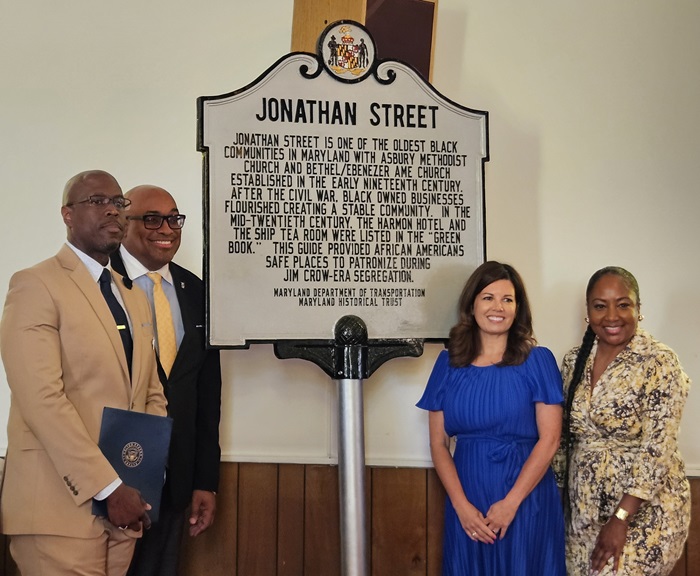Jonathan Street Marker Recalls History of Western Maryland Community
HAGERSTOWN, MD (May 30, 2024) – The Maryland Department of Transportation joined the Hagerstown community in celebrating the history of an African American enclave that emerged in Washington County in the 18th century.
A new roadside historical marker unveiled today commemorates an African American community who lived, worshiped and operated businesses along Jonathan Street in central Hagerstown that became an economic hub by the 1890s. The neighborhood includes an 18th century log cabin home to German immigrants and eventually Black families. MDOT discovered artifacts associated with these families during an archaeological dig.
“This historical marker symbolizes more than just the physical revitalization of the historic Jonathan Street community; it stands as a testament to the community's resilience and rich heritage," said Reggie Turner, co-founder of the Western Maryland Community Development Corporation and nominator of the historical marker. “It has been an immense privilege to contribute to this project, highlighting our collective commitment to preserve and celebrate the narratives that shape this vibrant community. Today, we commemorate not just a place, but a legacy of strength and unity that defines Jonathan Street."

Left to right: Tereance R. Moore and Reggie Turner, Western Maryland Community Development Corporation; and Dr. Julie Schablitsky and Jawauna Greene, Maryland Department of Transportation.
During the 19th and 20th centuries, the Jonathan St reet area grew into a community with homes, stores, restaurants, hotels and religious and fraternal organizations. Two establishments in the community were listed in the “Green Book" – a travel guide consulted by African Americans during the era of Jim Crow laws from the 1930s through the 1960s to identify businesses that were safe, or friendly, for African American travelers.
The new roadside historical marker was installed at the U.S. Post Office at 44 West Franklin St., near Asbury United Meth odist Church.
“On behalf of the Moore-Miller Administration, I'm honored to be a part of the celebration and commemorate this thriving African American community in Hagerstown," said Jawauna Greene, Maryland Department of Transportation Assistant Secretary for Public Affairs and Strategy. “Maryland's roadside historical marker program highlights the state's rich and diverse past for all to learn about and remember."
Dr. Julie Schablitsky, Chief Archaeologist and Director of the Maryland Department of Transportation Office of Cultural Resources also attended the unveiling along with representatives from the Maryland Historical Trust, Maryland Commission of African American History and Culture, Western Maryland Community Development Corporation, elected officials and local community members.
Maryland's Roadside Historical Marker Program is managed by the Maryland Department of Transportation and the Maryland Historical Trust to highlight the state's rich history.
Click here for more information on the program, including how to nominate a site for a roadside marker. Click here to research current historical markers across Maryland.